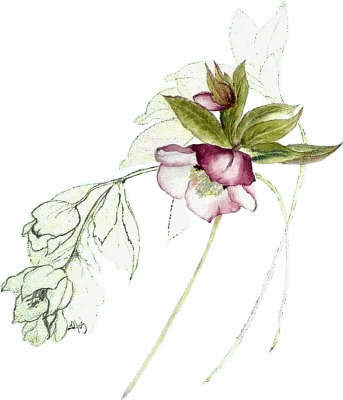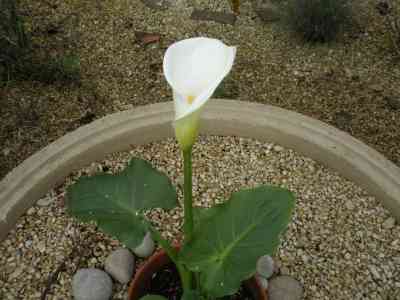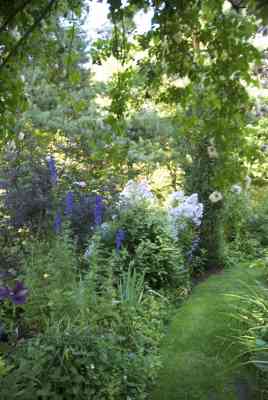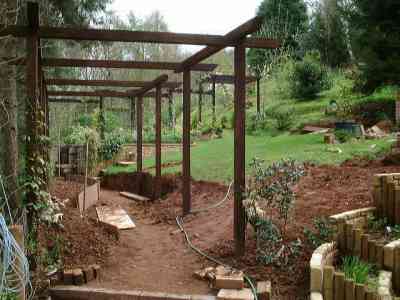Newsletter
Spring 2012

Newsletter |
 |
As I write this at the beginning of February we are experiencing a cold spell with hard night frosts (and not much better during the day) but what a difference a year makes. By this time last year we had had thick snow and weeks of hard frosts and were counting the cost in our gardens. My holly tree was stripped of its berries by the beginning of December 2010 but this winter the berries stayed on until this last week when the redwings have made short work of them. At our first meeting of 2012 in January several people, myself included, commented that they had been able to start work in their gardens due to the mild spell. This latest freeze will have stopped that but with better weather forecast I hope we will be able to restart soon.
I can't wait to get my propagator on the go and start off my latest batch of seeds including this year's HPS seed. Last week, looking at my various pots which have been lined up outside the greenhouse, I noticed that my libertia and fritillary seeds were germinating. The former were part of my HPS seed order last year and the fritillaries were my own saved from the plants in the garden. It will be interesting to see if they survive this weather. Don't forget, when you are dividing plants and potting up seedlings this spring, to save some for our Plant Sale on June 9th, on the morning of our monthly meeting. We estimate that if all members donated six plants each we would have a really good amount to sell to the public.
At the risk of sounding like “an anorak”, on January 1st I started keeping a daily record of the maximum and minimum temperatures in my unheated greenhouse to give me some idea of how hot or cold it is. So far, the coldest night has been that of 2/3 February when it reached -4.6º which put paid to a heliotrope I was hoping to get cuttings from. That will teach me to put the fleece over any vulnerable plants I hope to keep. I look forward to recording some higher temperatures soon.
Happy gardening.
Pleas do sometimes work! Your response to mine in January has been splendid. So thank you to everyone who has contributed an article to this edition, and especially to Alan Hale, who is such a stalwart with his thoughts from Mickleton.
The cover drawing this time comes from outside the Group. It is by Hazel Rainscourt, a gardener and artist who lives in Ledbury. She is not a 'botanical artist' in the formal sense, but I find her work very attractive. The image on the cover is a photograph of the painting I have and I hope you will like it too.
When you buy a plant, the label usually tells you the colour of the flower, the eventual height and spread, whether to place it in sun or shade, but never how long it will live. Occasionally the label may state: a short-lived perennial or a long-lived perennial, but how long is short and how short is long? In the first instance perhaps 3-4 years and in the second, 20 plus years?
Last autumn I bought two of the fashionable, and rightly so in my opinion, newly introduced echinacea hybrids, but the question is, how long will they be with me? We all know that there are many extraneous conditions which can affect the longevity of a plant. Is the soil ph acceptable? Have we got the position right, too much sun or too much shade; the soil too wet or too dry, the site too exposed and windy? Or is there too much competition from surrounding plants to allow growth? And then there is the problem of slugs and snails and other unmentionable soil-living beasties and viral infections it's best not to know too much about, for the plant to contend with. As if all the above isn't enough we have to suffer visitations from the neighbours' cats who find our friable soil much more attractive than a litter-tray. Fortunately most plants do seem to be adaptable and will even perform well in circumstances which are said not to be to their liking.
Noel Kingsbury wrote an interesting article on the subject in the August edition of the RHS 'The Garden' magazine, entitled, 'How long will my plants live?', although much to my disappointment, he does not answer his own question, not in terms of years anyway. Accepting that we all know what the terms, 'Annuals' and 'Biennials', mean he suggests that 'Perennials' is too broad a description for the remainder of the hardy plants we grow. In this context he mentions that we may be surprised to learn, that the definition of a perennial plant is: one that lives for longer than two years. He argues that there is a strong case for sub-dividing the category and for the labelling to take account of this. He suggests three divisions, namely - 'Short Lived Perennials' examples being, hollyhocks, aquilegias and some cultivars of achillea: 'Non-Clonal Perennials', which are clump-forming rather than spreading, such as Astrantia major, sedum, some heuchera and cultivars of Salvia xsuperba, and finally 'Clonal Perennials' which are those which expand and spread like hostas, anemones x hybrida, Geranium x oxonianum and so on.
Whilst agreeing he has a good point regarding the all-encompassing term 'Perennial', I'm not sure the nursery trade would want to label their plants 'Non-Clonal' and 'Clonal', fearing, no doubt, it could well confuse their customers and inhibit sales. And I'm not sure Hardy Planters would be in favour either. The status quo has a lot going for it. In the end does it really matter? Would we pick one plant in preference to another, because it's Clonal rather than Non-Clonal? Most of us pursue our own likes and preferences, be it roses, irises, heucheras, clematis, or just a general mix, not once considering how many years our selections will be with us, and accepting failures philosophically, and as an opportunity to use the space created to plant a new variety or something completely different.
However, out of interest, rather than real concern, I would still like to know, given optimum growing conditions, how many years my echinaceas will live. I very much doubt if the answer would be - three score years and ten!
Just to remind you all that the above national HPS scheme is alive and well within our Group
Eighteen of our Group members hold 22 plants between them, which were selected for conservation because they
The aim is to have four growers in a Group for each plant in the scheme.
Each of those growers is asked to fill up a simple form relating to the performance of the plant and the conditions it is grown in, just once a year for four years. The forms are always distributed in November/December if possible. During the four years it is hoped that the grower can propagate that plant, enabling more members of the group to grow it.
So, for four years a grower has the plant 'on loan', and hopefully can pass on cuttings and divisions. After that, it's theirs!
(After finding four growers the subsequent growers will not have to fill in a form! We will endeavour to give these 'extras' another label as well as the green one so the grower will know they won't be chased by us, but will know they have a 'special 'plant!)
Any rooted cuttings/divisions of a Conservation Scheme plant offered on the sales table will have a green printed label. I would ask any grower who propagates a plant to bring to our Group to pass on, to check with me or Jenny Constant who is helping me with the scheme, to make sure that we have a note of the new grower's name if it is a plant with less than four growers already. (They will need to fill in a form after they have had the plant for a year or less.) We have a stock of labels, so do please ask us for some if you don't have any spare ones at present.
A list of the plants we hold will be posted on the Group's noticeboard.
Thanks to all of you who are cooperating in the scheme. A new national coordinator has been appointed so there may be a few changes, but I doubt that they will affect our growers. You will no doubt have seen news of the Scheme in the national newsletters from time to time,
Let's hope we have a better season weatherwise this year and we can all get propagating.
As a follow on to Jackie’s ‘official’ piece on the HPS Conservation Scheme, we thought you might like a personal view from one of her growers.
I signed up at the November 2008 meeting when Jackie brought some cuttings she had taken from the conservation plant Bignonia capreolata. She caught me looking at them and asked if I would like to try one. She described a climber with orangey red trumpet flowers in early summer, a pretty tempting sales pitch, so of course I took one home. Once there I found lots of pictures on the internet confirming that this was a rampant climber smothered in voluptuous blooms.
The plant comes from moist forest in warm-temperate North America, where it scrambles up to 10 metres plus, holding on with its many twining tendrils (capreolata means with tendrils). Reading about cultivation in the UK, doubts began to form regarding its hardiness, to say nothing of the mythical fertile, moist, well drained soil in full sun.
So it spent its first two winters in a frost free greenhouse and the intervening summer in a pot in a sheltered sunny position, looking pretty sick until June when it put on a burst of growth. In the second summer I planted it out and it came through last winter unscathed with minimal protection, showing once again that hardiness is a complex mix of several factors. It is now 1.2 metres tall, so still some way to go before it smothers its support. I haven’t forgotten to mention the flowers - it has never had any! Neither has Jackie’s original plant, although hers is 2 x 2 metres and looks healthy. Our view is that Bignonia is not ‘garden-worthy’ in Worcestershire.
Knowing that the original plant was supplied by Bob Brown, I looked at his website. This has a photo of Bignonia capreolata ‘Dragon Lady’ in bloom against a trellis. He says this is an improvement on the ‘straight’ species which tends to bloom just at the top – we would settle for that!
As my plant is now the only survivor of the original batch of cuttings I have tried to propagate it for further distribution. Last summer I took four cuttings, using any vaguely suitable material I could find and setting them round the edge of a pot covered with a poly. bag. Of these three died and the last was rescued in a heated propagator but still looks sickly.
 So, I have become a minor authority on a rather uninteresting evergreen climber which refuses to flower, but not discouraged I have since taken on more plants, one of which, Zantedeschia aethiopica ‘Glen Coe’ is a star. The offset I got in November 2010 was tiny but in only a year it has made a vigorous handsome plant which came into bloom the following November. What a peculiar autumn that was.
So, I have become a minor authority on a rather uninteresting evergreen climber which refuses to flower, but not discouraged I have since taken on more plants, one of which, Zantedeschia aethiopica ‘Glen Coe’ is a star. The offset I got in November 2010 was tiny but in only a year it has made a vigorous handsome plant which came into bloom the following November. What a peculiar autumn that was.
Writing this article has been easy as most of the information I needed was already on the Annual Feedback Forms. As Jackie has explained, this is the commitment you make when taking on a conservation plant, along with propagation when possible. I reckon this is a good deal for the grower, in return for which you get a potentially interesting plant for nothing. I know there are other group members who have been ‘doing their bit’ for a lot longer than me and I would love to read about their experiences of other conservation plants. Something for the next issue perhaps?
Pershore College Open Day
Pershore College is holding its Open Day on 26 May. Please come along and support our local college and the HPS members from Worcestershire and Southern Counties who are the volunteers for the Perennial Garden there. We love visitors! (And would be very happy to have another volunteer or two........)
Feckenham Flower and Garden Festival
This triennial festival to raise funds for our 12th Century Parish Church will be held on the weekend of Saturday 12 and Sunday 13 May 2012, from 12 – 6 pm. Approximately 30 gardens open, flower festival in the church, plant sales, WI teas and barbecue/pig roast. Ample parking. Admission £5 per adult.
Feckenham is situated in Worcestershire on the B4090 between Droitwich and Alcester.
This will take place on 22 April, and the committee has agreed to stage a display on similar lines to that put on at last year's sale. John McGhee will take the lead, with Bev Drewitt, Celia Guest and David Pollitt as his main assistants on the day. They would welcome help from members in taking a turn manning the stand. It was a really good day last year and promises to be so again. If you would like to join them, please talk to John
Malvern Spring Show 10 - 13 May 2012
Opening times 9am – 6pm
Representing the HPS, Worcestershire group will be putting on a display at the Malvern Spring Show. We are currently looking for people to help in the following areas: overall planning on the design layout of the stand, with particular emphasis on a plant and photographic display; help with build up of the stand prior to the opening of the show; volunteers for stand duty during the show and help with breaking down the stand on Sunday evening. Anyone who helps on the stand during the day will have free entry to the show.
If you can help, please email John McGhee or talk to him at either the March or the April meeting.
Malvern Autumn Show 29/30 September 2012
We shall again have a stand representing the national Society as well as the Worcestershire group, with a small display and our information boards. Pippa Hilton has agreed to design the plant display with plants from Bob Brown and using more varieties than last year. Judith Doughty has offered to put together photos and short texts from 'Cornucopia' and our own newsletter to show the HPS ideas and activities. She would welcome others' thoughts, bearing in mind space limitations. As last year, we shall need members to man the stand, and again, this would mean free entry to the show.
Lecture Day and Annual General Meeting 23 March 2013
Worcestershire group has offered to host the Lecture Day and AGM next year. It will be held at Pershore College, where rooms have been booked. Marilyn Wrightson is contacting the preferred speakers: Dr T Walker, Horti Praefectus (Director), University of Oxford Botanical Garden and Harcourt Arboretum, and Dr Andrew Ward. The national Administrator, Pam Adams, carries out most of the pre-event tasks and obviously deals with the AGM papers and formalities. But we shall be needed on the day to act as hosts.
I first came to the HPS meeting in the autumn as a visitor. I bought a red-flowering sage, and having listened to the talk about taking cuttings, I am now the proud possessor of six extra plants from the original one.
The talk on composting this month [January - Ed.] reminded me of my mother. She had a seaside bungalow near Christchurch in Dorset. In the garden by the back door, there was a disused concrete coal bunker. She used to put all the lawn cuttings, weeds and garden waste into the top of the bunker, never attended to the contents in any way and she continually had fantastic friable compost coming out of the hatch in the base.
Oh, what a crazy year! The warmest, the driest, the coldest … the records continued to tumble. And in the garden, confusion reigns.
This time last year we were counting the cost. The Pittosporum tenuifolium 'Tom Thumb' was brown and crisp as was the prostrate rosemary, not to mention the bay in its pot, all of which had withstood the previous winter, in itself hard enough by the standards of recent years. Gardening colleagues reported similar losses. Don't be hasty, the pundits cautioned. Cut it back, it may re-grow. Scrape back a bit of the bark and if you see green on the stem …. And sure enough …. so out came the secateurs. But as the season advanced into autumn further investigation showed roots devoid of life and one by one the victims were committed to the shredder.
Some were not mourned. The Phlomis fruticosa had never really been loved which is probably why it had been relegated to the least promising part of the garden, like a lone diner ushered to the table next to the toilets in a restaurant. But others will be sorely missed, such as the deep red standard rose growing close to the house, a moving-in present from a friend some twenty years ago.
Yet clouds have silver linings. The Piptanthus nepalensis, although clearly dead, had clung onto its large flat seeds pods all winter. The seeds were harvested in April and sown into pots where they quickly germinated. Pricked out and potted on, they are now fine plants. One or two will find a home in the garden. The remainder will make a nice offering for the sales table. Interestingly, Leila Jackson of Wall End Nursery near Leominster reported that her P. nepalensis had come through the winter unscathed but it appears she cuts hers down every autumn which might be a wise precaution in future.
Right from the outset, 2011 saw precipitation levels a mere faction of the average for our area and although the summer was not particularly hot the unusually mild autumn and early winter produced a record mean temperature for the year as a whole. Some plants relished the conditions - hollyhocks and foxgloves reached unprecedented heights - while others went into a state of animated suspension or curled up their leaves and turned brown, only to re-grow when the first rains of autumn arrived, the geums being a case in point. But a stroll round the garden just before Christmas revealed a picture of complete confusion.
Yes, some plants were performing true to textbook; the winter jasmine was in flower, as was the Clematis cirrhosa 'Freckles', and the white flowers of the Helleborus niger, too, were a welcome sight. The Iris unguicularis, though healthy and usually reliable, had not a single flower. And why on earth should there be a large, perfect bloom on the Clematis 'Jackmannii' in December? Not to mention the the hollyhock, and the dozen or so other plants I saw in flower? The Nicotiana mutabilis that had sulked all summer despite being encouraged with the occasional can of water were now lush and putting on a wonderful display. Helenium 'Sahins Early' is known for its extended flowering season yet not only was it still blooming in mid-December, but fresh buds were set to extend its season still further. Reference had to be made to the RHS 'Encyclopaedia of Plants and Flowers' to confirm that the normal flowering season for ipheion is spring after which they go underground. So why had ours appeared in October and proceeded to flower till Christmas and beyond? And had I really needed to take cuttings of the Salvia 'Indigo Spires'? Still in full flower, it appeared to have simply shrugged off the recent frosts. The David Austin pillar roses had recovered from the severe frost dieback earlier in the season and produced a second flowering after their first flush. But in October the whole cycle had started up again and here they were flowering merrily away with more blooms to come. Will they have exhausted themselves for next year, I wonder. Similar questions were raised by the many other plants I recorded on my tour.
When we experience a crazy year like the last one we blame it on 'climate change'. No, what you are experiencing, the gurus assure us, is weather. Yet, in the same breath they tell us that extremes of weather are and will increasingly be a feature of global warming. I am confused, and my plants too.
| What is a weed? I have heard it said that there are sixty definitions. For me, a weed is a plant out of place. | Donald Culrose Peattie |
| A weed is but an unloved flower. | Ella Wheeler Wilcox |
| Plant and your spouse plants with you; weed and you weed alone. | Author Unknown |
| When weeding, the best way to make sure you are removing a weed and not a valuable plant is to pull on it. If it comes out of the ground easily, it is a valuable plant. | Author Unknown |
| They know, they just know where to grow, how to dupe you, and how to camouflage themselves among the perfectly respectable plants, they just know, and therefore, I’ve concluded weeds must have brains. | Dianne Benson, 'Dirt', 1994 |
| What is a weed ? A plant whose virtues have not yet been discovered. | Ralph Waldo Emerson, 'Fortune of the Republic', 1878 |
| Weeds are flowers too, once you get to know them. | A.A. Milne |
| A weed is a plant that has mastered every survival skill except for learning how to grow in rows. | Doug Larson |
| Even the richest soil, if left uncultivated will produce the rankest weeds. | Leonardo da Vinci |
| Sweet flowers are slow and weeds make haste. | William Shakespeare |
| Roses are red,
Violets are blue; But they don’t get around Like dandelions do. | Slim Acres |
| But make no mistake: the weeds will win; nature bats last. | Robert M. Pyle |
For many years now I have taken a walk around the garden on Boxing Day morning to see what is in flower so I can pick a few sprays of fresh flowers as a posy on the lunch table. This year I was amazed at just what was unexpectedly still in flower and fresh; I think about 40 things.
The star of the garden at this time of year, albeit a very untidy one, is a large shrub of Lonicera purpusii 'Winter Beauty'. The perfume on a sunny day is delicious. I first saw it on a little mountain railway station in Switzerland many years ago on a winter walking holiday. I had to follow my nose along the platform to find out where the scent was coming from. Mine is draped with Clematis cirrhosa 'Wisley Cream', flowers of the same colour, hanging down. It all badly needs a prune, but with its perfume this time of the year, I can forgive it a lot. Two or three stems in a vase scents a room.
Three roses, 'Graham Thomas', 'The Pilgrim', another yellow, and a very old unnamed white by the gate actually had 15 blooms. Masses of Cyclamen coum, in all colours from pale white-ish pink to deep magenta, the very first grown from HPS seed many years ago. Iris stylosa is a regular in December, plus lots of hellebores, more than usual. Must get around to cutting the leaves off to show them better. Dianthus were a surprise, a cream one (no name), 'Letitia Wyett', 'Sugar Plum' and 'Clare' all had several cutting stems. Penstemon 'Apple Blossom' and 'Vanilla Plum' were still performing. On the rockery a patch of arabis has been there since the spring and now has hepaticas poking through.
I thought I had cut back all the erigerons, but 'Quakeress' had put up a last stem of five pale mauve daisies. Lots of snowdrops: where, oh where, do the name labels go? A big clump by an old tree stump looked lovely. Elsewhere, 'John Gray' and 'Helen Tomlinson', 'Lyn' and three others unnamed were up and flowering. Some people say they all look alike but when a clump is well established they do look different.
An old bergenia tucked under a big holly tree is always reliable and Bergenia 'Reitheim' also had two sprays of pink flowers. I was able to pick from chrysanths 'Killerton Tangerine', 'Golden Greenheart' and 'Angela Blundell'. Hanging on the wall two prostrate rosemarys, a pale and a darker one called 'Fota Blue', have noses of the daffodils poking through. Another blue is Lithodora diffusa 'Heavenly Blue', that, unless I prune it back, continues to flower forever.
The erysimums also perform so well: 'Bowles Mauve' flowers itself to death; also lots of colour on 'Jenny Bloom', 'Spice Island' and Apricot Twist'. They do so well I must put some more in later this year or take some cuttings.
In conclusion, primulas 'Tie Dye', 'Sunshine Susie' and the double white 'Schneekissen' are a bright patch of colour. That's quite enough plant names for you to read from one person's garden, but do go outside with a pen and make a note of what's in flower in yours. I think you'll be surprised.
 It is almost ten years since my husband, Chris, and I moved to our present home and garden or should I say Garden and Home? It was no ordinary move; we had to wait seven weeks for the keys and finally moved in during the first week of June. Up to that point we had lodged with a very good friend in Eckington. We had descended on our friend with three Luton vans full of plants, cuttings, bulbs, corms and a greenhouse with staging, plus three or four hanging baskets duly planted up for the new house front.
It is almost ten years since my husband, Chris, and I moved to our present home and garden or should I say Garden and Home? It was no ordinary move; we had to wait seven weeks for the keys and finally moved in during the first week of June. Up to that point we had lodged with a very good friend in Eckington. We had descended on our friend with three Luton vans full of plants, cuttings, bulbs, corms and a greenhouse with staging, plus three or four hanging baskets duly planted up for the new house front.
Finally, we moved in without our furniture. It was a public holiday that week, the Nation was celebrating the Golden Jubilee. But we had a garden! A very large garden plus a wood, in all nearly 2 acres. Our predecessor had just grown vegetables. I wanted a garden full of plants, shrubs, trees, etc. The greenhouse was the first thing to be assembled which was needed to house, amongst others, our collection of exotics, agapanthus, orchids, pelargoniums and at that time a young frangipani tree I had grown from seed.
So began the great landscaping project.
Not an easy task, it would entail excavation, terracing and the building of numerous retaining walls. Our garden was on a slope some of which was at a 40° angle.
 What was needed was a backbone, a structure: we built a 24 foot pergola across the garden. Another pergola, this time at 90° to the first one, was constructed forming a pathway. The pergola was built across the left half of the garden and would take climbing roses, white roses: 'Rambling Rector' and 'Kiftsgate' were chosen, along with variegated hedera and white jasmine. This wide feature unites the two halves of the plot and gives height and horizontal balance.
What was needed was a backbone, a structure: we built a 24 foot pergola across the garden. Another pergola, this time at 90° to the first one, was constructed forming a pathway. The pergola was built across the left half of the garden and would take climbing roses, white roses: 'Rambling Rector' and 'Kiftsgate' were chosen, along with variegated hedera and white jasmine. This wide feature unites the two halves of the plot and gives height and horizontal balance.
A small stone wall was constructed which would later become part of ‘The White Garden.’
Alongside and at a 90° angle yet another retaining wall was built forming a pathway, now known as Stable Walk . This huge wall travels down the length of the garden to the first of the greenhouses and compost bins.
A Fernery was also to be included in the grand design. The Fernery was built in the shape of a Roman forum. We had visited Rome that year. After many hours and days of intense labour, digging, barrowing away the spoil, the Fernery began to take shape.
Cement footings were laid to take the stone/brick walls. Leaf mould and compost filled the planting beds created. This entire area is in shade for the most part and fairly protected from frost, which suited a variety of ferns: adiantum, asplenium, athyrium, blechnum, dryopteris, matteuccia and polystichum. On our trips to gardens and garden nurseries we added to our collection.
Over the years the ferns have grown and matured, have been divided and replanted in other suitable areas of the garden. Twice a year they are top dressed with leaf mould and well rotted horse manure.


To be continued..............
The Group's first Open Plant Sale will be held between 10:30am and 12:30pm. at Peopleton Village Hall on Saturday June 9th and we need your help!
Many groups hold annual plant sales, in some instances meeting the entire cost of their speakers for the year from the proceeds. In practice it probably takes a number years to build up the following necessary to achieve that level of success. But the benefits of an event such as this go beyond just fund-raising. A plant sale helps publicise the group and the HPS at large and forges links with the community. It also lends the group a common sense of purpose that is hard to engender from indoor meetings alone. For all these reasons it is hoped that members will support this venture.
Members are asked to donate plants; the cost of compost and pots can be reimbursed if required. Plants should be of a good quality, nicely presented, weed-free and in clean pots, labelled but not priced. As well as perennials, annuals, shrubs and even vegetable seedlings are acceptable. Please bring plants to the hall between 9 and 9:30 on the day of the sale. Alternative arrangements can be made if you are unable to bring them yourself. Any plants left over from the sale will be put on the donated plants sales table at the afternoon meeting, unsold plants being reclaimed at the end of the day as usual. Having delivered plants in the morning it is hoped that as many members as possible will stay to assist in selling and also take the opportunity to buy!
On a personal note, I derive great satisfaction from growing plants, and selling them in aid of a good cause is an added bonus. I hope you feel the same. If you were unable to sign the forms at the March meeting, please let me know if you are able to provide plants or help with the sale.
Worcestershire Group members will be aware that they also need be members of the Hardy Plant Society (HPS). HPS exists to provide information and encourage an interest in hardy perennials. It is a friendly society with lots of opportunities to meet and share ideas and information. The benefits of being a full member of HPS are well documented.
National membership costs £17 per year for single or £19 per year joint membership, one of the least expensive subscriptions for a national gardening society.
There have been endless articles on this subject showing pictures of jolly little hens and extolling the virtues of their presence. I have yet to read an article that highlights the problems. I had no intention of inviting my three Pekin Bantams to share the delights of my walled cottage garden, along with three Call Ducks, who incidentally cause no problems at all, in fact keep the slugs down.
The problem has occurred because I have two cockerels. My Araucana is a most handsome fellow with his own flock of ageing brides and I therefore need to increase this line before they drop off their perches. Sadly that breed do not go broody, ie sit on eggs to hatch, hence the introduction of the Pekin trio. Faced with competition the two cockerels were fighting to the death, so three fluffy Pekins gained entrance to the garden. They thought they were in seventh heaven; the first morning they shot round trampling and pecking at all my precious seedlings, scratching away at will.
My garden is very reliant on the odd unexpected seedlings. I have waves of purple and white honesty (lunaria) and both colours of sweet rocket (Hesperis matronalis) which mingle so beautifully with all the aquilegias in May; I have many chance seedlings of Geranium pratense; some good, some bad, but I doubt I will ever see those again. They have avoided the euphorbias (poisonous) so they do have some brain. They have a particular liking for scratching up the dianthus - one has just gone flying through the air - it was old, I suppose. They have found the sunniest, warmest spot for their dustbath against the south facing wall, amongst the roots of Clematis 'Prince Charles'. I just hope the roots are deep enough to survive. They roost during the day when not creating havoc on the garden seat, which is all very charming but, come the summer, the seat will be impossible to sit on. There is now poultry muck all round the lawn which my dear husband tramples in, and as he is not one to change his shoes in the house, it is a recipe for some disharmony..........
Two good points - I notice they are eating all the bird seeds that drop to the ground, which, hopefully, will prevent all those unwanted sunflowers. They are obviously eating all sorts of grubs nestling in the plants, but will the ladybirds survive? I do have superb compost as the poultry manure from two henhouses speeds up the process and it is ready to use in six months provided I turn it regularly.
I dread the spring in the vegetable patch. They are already discovering the purple sprouting leaves, and spinach seedlings won't stand a chance. A little fencing off is going to be necessary - at least I can keep them out of the greenhouse area where they could cause mayhem.
Is it worth it? I'm not sure. They are very endearing, and as long as they produce a new batch of hens I think I will forgive them all the destruction and learn to garden in a more laidback manner!